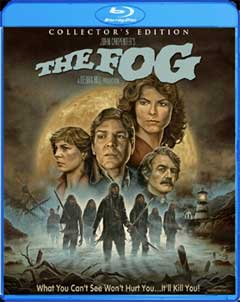 THE
FOG (1980) Blu-ray
THE
FOG (1980) Blu-rayDirector: John Carpenter
Scream Factory/Shout! Factory
 THE
FOG (1980) Blu-ray
THE
FOG (1980) Blu-rayTHE FOG rolls into high definition with plenty of bells and whistles courtesy of Shout! Factory’s “Scream Factory” line of collector’s Blu-rays and DVDs.
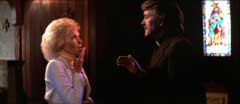
As the clock strikes midnight denoting the one hundredth anniversary of Bodega Bay-adjacent fishing village Antonio Bay’s founding, the entire town comes unglued with an hour of telekinetic chaos from damaged property, objects moving by themselves, car alarms, earth tremors, and much shattered glass. These outbursts are just the beginning of something far more sinister and deadly starting with the mysterious disappearance of three men on a fishing boat. As nightfall and the next evening’s centennial celebration nears, lighthouse DJ Stevie Wayne (Adrienne Barbeau, SWAMP THING), fisherman Nick Castle (Tom Atkins, HALLOWEEN III), hitchhiker Elizabeth (Jamie Lee Curtis, TERROR TRAIN), alcoholic priest Father Malone (Hal Holbrook, CREEPSHOW), councilwoman Kathy Williams (Janet Leigh, PSYCHO) and her assistant Sandy (Nancy Loomis, HALLOWEEN) discover there is more death and destruction to come; and that it is related to the tale of vengeful ghosts told by old Mr. Machen (John Houseman, GHOST STORY) from the hundred year old shipwreck at the bottom of the bay who now lurk in the encroaching fog.
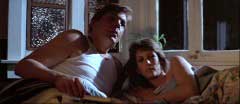 The
third theatrical feature of John Carpenter – not counting his TV work
– THE FOG was nevertheless his sophomore horror effort in the wake of
HALLOWEEN’s massive success which led to the two-picture deal with Avco
Embassy that produced this film and ESCAPE FROM NEW YORK. For his follow-up
effort, Carpenter and producer/co-writer Debra Hill moved away from the suburbs
(Los Angeles subbing for Haddonfield, Illinois) and the abstract notion of the
boogeyman in favor of the picturesque California coast and a campfire ghost
story loosely inspired by the wreck of the galleon the Saint Augustin near the
Drakes Estero inlet of Point Reyes. The crosscutting between the different characters
works for much of the film to develop the plot, although the viewer is sometimes
left wanting a bit more interaction between characters and discussion of events
that should really be giving these characters pause. The crosscutting does at
times detract from the tension during the climax as we cut back and forth between
the church siege and the lighthouse (the similar climax of PRINCE OF DARKNESS
is better judged in its staging and cutting).
The
third theatrical feature of John Carpenter – not counting his TV work
– THE FOG was nevertheless his sophomore horror effort in the wake of
HALLOWEEN’s massive success which led to the two-picture deal with Avco
Embassy that produced this film and ESCAPE FROM NEW YORK. For his follow-up
effort, Carpenter and producer/co-writer Debra Hill moved away from the suburbs
(Los Angeles subbing for Haddonfield, Illinois) and the abstract notion of the
boogeyman in favor of the picturesque California coast and a campfire ghost
story loosely inspired by the wreck of the galleon the Saint Augustin near the
Drakes Estero inlet of Point Reyes. The crosscutting between the different characters
works for much of the film to develop the plot, although the viewer is sometimes
left wanting a bit more interaction between characters and discussion of events
that should really be giving these characters pause. The crosscutting does at
times detract from the tension during the climax as we cut back and forth between
the church siege and the lighthouse (the similar climax of PRINCE OF DARKNESS
is better judged in its staging and cutting).

The winning elements are still the performances – particularly Barbeau and Holbrook – Carpenter’s throbbing score, and Dean Cundey’s thoroughly striking cinematography from its expansive coastal landscape shots to the intricate lighting of church interiors. Carpenter’s and Hill’s original script and the first cut of the film skimped on grisly details of the ghosts’ murderous encounters including almost the entirety of Sea Grass massacre which was elided with a fade-out. Re-shoots were ordered with some rather tame gore supervised by Rob Bottin (THE HOWLING) – who also played Blake – while Carpenter and a skeleton crew grabbed shots to flesh out the opening montage, re-shoots of the discovery of the body below decks and rebuilding the lighthouse roof on a soundstage to stage a more tense confrontation between Barbeau and the ghosts. Additional closer angles of the ghosts (usually doubled by production designer/editor Tommy Lee Wallace) creeping up on victims were also added. The finished product is not without flaws, but it remains one of Carpenter’s finest horror films and still remains a Halloween (and foggy evening’s) favorite for many.
 Like
HALLOWEEN, THE FOG suffered horribly on home video with its Panavision compositions
chopped up. Nelson Entertainment’s panned-and-scanned VHS release cropped
away important detail like the “SIX MUST DIE” message on the driftwood
and the “3” scrawled by the walking corpse in the morgue. The lettering
of the opening credits changed size as some shots were enlarged while others
were squeezed. Magnetic Video’s laserdisc and Nelson’s later edition
were also panned-and-scanned (as were the Japanese releases from the same labels
presumably). It was not until 1995 that Image Entertainment produced a special
edition with commentary by John Carpenter and Debra Hill as well as an isolated
score track (also chapter-encoded), theatrical and TV spots, and an outtake
reel. When MGM acquired the Avco Embassy library, they released a budget VHS
edition before getting serious with a 2003 special edition DVD featuring a new
16:9 transfer, original mono and 5.1 remixes, as well as the laserdisc commentary
from Carpenter and Hill (and other extras carried over onto the Shout! disc
discussed below). The downside of MGM’s release was that it was one of
those double-sided discs with a needless 4:3 panned-and-scanned version (newly
prepared since they recreated the opening credits on a creditless panned-and-scanned
version of the opening sequence). Sony reissued the disc in 2005 as a single-sided
with the widescreen version (and extras) only. Although the back cover carried
Sony’s usual “Mastered in High Definition” hyperbole, it was
a direct port of the widescreen side of the MGM disc (same menus, same file
size, same bitrate, and no noticeable difference in picture quality).
Like
HALLOWEEN, THE FOG suffered horribly on home video with its Panavision compositions
chopped up. Nelson Entertainment’s panned-and-scanned VHS release cropped
away important detail like the “SIX MUST DIE” message on the driftwood
and the “3” scrawled by the walking corpse in the morgue. The lettering
of the opening credits changed size as some shots were enlarged while others
were squeezed. Magnetic Video’s laserdisc and Nelson’s later edition
were also panned-and-scanned (as were the Japanese releases from the same labels
presumably). It was not until 1995 that Image Entertainment produced a special
edition with commentary by John Carpenter and Debra Hill as well as an isolated
score track (also chapter-encoded), theatrical and TV spots, and an outtake
reel. When MGM acquired the Avco Embassy library, they released a budget VHS
edition before getting serious with a 2003 special edition DVD featuring a new
16:9 transfer, original mono and 5.1 remixes, as well as the laserdisc commentary
from Carpenter and Hill (and other extras carried over onto the Shout! disc
discussed below). The downside of MGM’s release was that it was one of
those double-sided discs with a needless 4:3 panned-and-scanned version (newly
prepared since they recreated the opening credits on a creditless panned-and-scanned
version of the opening sequence). Sony reissued the disc in 2005 as a single-sided
with the widescreen version (and extras) only. Although the back cover carried
Sony’s usual “Mastered in High Definition” hyperbole, it was
a direct port of the widescreen side of the MGM disc (same menus, same file
size, same bitrate, and no noticeable difference in picture quality).
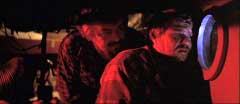
THE FOG hit Blu-ray first abroad in the UK, France, Germany, and a few other countries in a reportedly underwhelming presentation some on the internet have claimed to be upscaled – screencaps around the web have little detail over the DVD – while others have claimed it’s heavily filtered. I haven’t seen the import, but Shout! Factory has created a new HD master under the supervision of cinematographer Cundey. Their 1080p24 MPEG-4 AVC-encoded Blu-ray (2.35:1) is darker than the previous MGM DVD but also more detailed. During the opening credits, the shadow of a crew member – maybe Carpenter or Cundey since the figure looks up from leaning behind what might be the camera and darts away – is visible on the side of the Olema inn during the executive producer credit. In the jump scare featuring Janet Leigh and Hal Holbrook in the church, you catch a glimpse of Holbrook in the shadows already in character with his head in his hands rather than just waiting for his cue to lurch out at Leigh. In the POV shot through the church study window of the fog coming up the driveway, you can see the silhouettes of the ghosts. Where once there was a silhouette and glowing red eyes, the details of Blake’s face (Rob Bottin’s self-applied make-up) are visible even in long shot. Cundey’s use of blue and red gels in certain scenes is also more pronounced here. Some lens flare during night exteriors is also more evident, and some of Ray Stella’s Steadicam shots look a bit bumpier and less fluid than before, but not enough to upset the film’s atmosphere (at times it’s like experiencing the film anew). The original mono mix is presented here in DTS-HD Master Audio 2.0 while a front-heavy 5.1 upmix (also DTS-HD) has more presence and may be the same one that was done for the MGM release. Optional English SDH subtitles are also included.
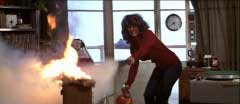 The
Carpenter/Hill commentary track is a bit dry but also extremely informative.
The discuss the origins of the project from a visit to Stonehenge following
the completion of HALLOWEEN, the location scouting, and how the some of the
effects were achieved in-camera and others as multi-pass opticals (as well as
the jump scare involving Hal Holbrook where Metrocolor’s technicians were
able to darken part of the frame and bring up the levels within the same shot
at the right moment). They also discuss the name origins of several characters
from old girlfriends and boyfriends to schoolmates and even acquaintances of
the time (Mrs. Kobritz being named after ELVIS producer Richard Kobritz who
later produced CHRISTINE), and point out all of their personal belongings that
made their way into the film as props. Hill elaborates on Carpenter’s
use of the Panavision frame, as well as the utility of cinematographer Cundey’s
custom lighting van (which helped immeasurably during the re-shoot stage where
they had to grab several quick shots at night to be edited into the opening
montage). Carpenter also expresses his love for the locations (he still owns
a house he bought in Inverness, California).
The
Carpenter/Hill commentary track is a bit dry but also extremely informative.
The discuss the origins of the project from a visit to Stonehenge following
the completion of HALLOWEEN, the location scouting, and how the some of the
effects were achieved in-camera and others as multi-pass opticals (as well as
the jump scare involving Hal Holbrook where Metrocolor’s technicians were
able to darken part of the frame and bring up the levels within the same shot
at the right moment). They also discuss the name origins of several characters
from old girlfriends and boyfriends to schoolmates and even acquaintances of
the time (Mrs. Kobritz being named after ELVIS producer Richard Kobritz who
later produced CHRISTINE), and point out all of their personal belongings that
made their way into the film as props. Hill elaborates on Carpenter’s
use of the Panavision frame, as well as the utility of cinematographer Cundey’s
custom lighting van (which helped immeasurably during the re-shoot stage where
they had to grab several quick shots at night to be edited into the opening
montage). Carpenter also expresses his love for the locations (he still owns
a house he bought in Inverness, California).
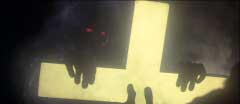
Shout! Factory has also recorded a brand new commentary track featuring Adrienne Barbeau, Tom Atkins, and co-editor/production designer Tommy Lee Wallace, moderated by “Horror’s Hallowed Ground” host Sean Clark. Wallace is the main source of background information with Barbeau and Atkins functioning less as moderators than prompters, but they have their own share of anecdotes. Barbeau talks about Carpenter contacting her to work on “Highrise-” which later became SOMEONE’S WATCHING ME, their subsequent marriage, and their attempts to keep things professional on-set. Of the film, she reveals the real-life inspiration for her “night owl” DJ character, acting in reverse for the climactic scenes (since there was no physical way to make the fog recede), and points out her mother and her ex-boyfriend as extras (her ex also appears in real photographs used as props to represent Andy’s [Ty Mitchell, HALLOWEEN II] father). Atkins reveals that the initial pressbook misidentifies him as his character “Nick Castle” – a name borrowed from HALLOWEEN’s “Shape” actor (who later went on to a directorial career of his own) – and this is substantiated by several enlargements from said pressbook in the disc’s photo gallery section. Wallace recalls what scenes were shot on location, on sets (including the pick-up scenes), and even points out some bits shot in Barbeau’s own home that she doesn’t recall (although Barbeau is the one to point out a bit shot in Wallace’s own living room that he missed). He also highlights the contributions of art director Craig Stearns (ONE DARK NIGHT) and assistant art director Randy Moore (FRIGHT NIGHT 2) who have both since become regular collaborators on a number of Stephen King film and miniseries adaptations. He also muses on the “Nancy Loomis character” common to the early Carpenter films (and HALLOWEEN III). Wallace also goes into a bit more detail than Carpenter about why the first cut of the film didn’t work and the steps they took to fix it. It’s not as informative as the Carpenter/Hill track, but it’s still quite an enjoyable listen as all four participants are thoroughly engaged in the screening and sometimes react like regular viewers (particularly the fans). NOTE FOR HARDCORE FOG FANS: Wallace also finally explains what a “Stomach Pounder” is.
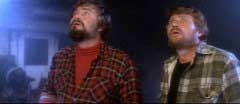 In
“My Time in Terror” (21:46), actress Jamie Lee Curtis is frank in
that she doesn’t believe THE FOG is that good of a film and that her part
is smaller than it seems (she says Carpenter wrote the role for her because
he felt guilty because she had received any other film offers since HALLOWEEN
did not do well at the box office until it was re-reviewed). While Barbeau on
the commentary track says the fact that she and Carpenter were just married
caused no tension with Hill (who subsequently dated Barbeau’s ex for a
few years), Curtis says she was to distracted by her “film parents”
break-up to really appreciate the advance in Carpenter’s craft between
this film and HALLOWEEN. She also discusses her subsequent “scream queen”
films PROM NIGHT and TERROR TRAIN, as well as the Australian ROAD GAMES (in
which the crew hated her because the producers reportedly fired the Australian
actress originally cast in order to hire Curtis). She felt that all concerned
with HALLOWEEN II were lacking passion and claims to have done it only for the
fans. In “Dean of Darkness” (18:41) describes how he changed his
film school major from art direction to cinematography and then worked on several
films doing second unit and inserts as well as several low budget films on which
Debra Hill served as script supervisor. It was Hill who contacted him about
working with Carpenter on HALLOWEEN, and he describes Carpenter as a visual
storyteller with which he worked out ways to use composition and lighting to
emotional effect. THE FOG afforded them the opportunity to experiment with the
same elements on more expansive locations in a less realist fashion due to the
ghost story aspect while ESCAPE FROM NEW YORK had more production designed environments
(and gave him the first opportunity to use new HMI lights in conjunction with
Panavision’s new faster lenses). On THE THING, he learned not only to
light Rob Bottin’s effects creations creatively to disguise the seams
and brushstrokes, but also to light them in a way that accentuates their mysteriousness.
In
“My Time in Terror” (21:46), actress Jamie Lee Curtis is frank in
that she doesn’t believe THE FOG is that good of a film and that her part
is smaller than it seems (she says Carpenter wrote the role for her because
he felt guilty because she had received any other film offers since HALLOWEEN
did not do well at the box office until it was re-reviewed). While Barbeau on
the commentary track says the fact that she and Carpenter were just married
caused no tension with Hill (who subsequently dated Barbeau’s ex for a
few years), Curtis says she was to distracted by her “film parents”
break-up to really appreciate the advance in Carpenter’s craft between
this film and HALLOWEEN. She also discusses her subsequent “scream queen”
films PROM NIGHT and TERROR TRAIN, as well as the Australian ROAD GAMES (in
which the crew hated her because the producers reportedly fired the Australian
actress originally cast in order to hire Curtis). She felt that all concerned
with HALLOWEEN II were lacking passion and claims to have done it only for the
fans. In “Dean of Darkness” (18:41) describes how he changed his
film school major from art direction to cinematography and then worked on several
films doing second unit and inserts as well as several low budget films on which
Debra Hill served as script supervisor. It was Hill who contacted him about
working with Carpenter on HALLOWEEN, and he describes Carpenter as a visual
storyteller with which he worked out ways to use composition and lighting to
emotional effect. THE FOG afforded them the opportunity to experiment with the
same elements on more expansive locations in a less realist fashion due to the
ghost story aspect while ESCAPE FROM NEW YORK had more production designed environments
(and gave him the first opportunity to use new HMI lights in conjunction with
Panavision’s new faster lenses). On THE THING, he learned not only to
light Rob Bottin’s effects creations creatively to disguise the seams
and brushstrokes, but also to light them in a way that accentuates their mysteriousness.

In the vintage press kit featurette “Fear on Film” (7:42) in which Carpenter, Hill, Leigh, Curtis, and Barbeau muse on the titular subject and compare Carpenter to Hitchcock, while the MGM-produced “Tales from the Mist” (27:58) is a more comprehensive retrospective piece featuring Carpenter, Hill, Barbeau, Wallace, and Cundey (along with some comments from Curtis extracted from the aforementioned vintage featurette). There is some repetition from the commentary track, but it’s fleshed out by the contributions of the others. Also carried over from the MGM disc is the outtakes reel (4:10) featuring a collection of dialogue gaffs, antics from ghost extras, and some technical and effects mishaps, as well as an effects test reel (2:39) – an Easter Egg on the MGM disc – that includes on-set fog wrangling as well as trial versions of some of the opticals (including a more elaborate version of the power station explosion).
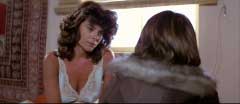 Sean
Clark also hosts another episode of “Horror’s Hallowed Grounds”
(20:22) in which he pays visits to all of the film’s major locations showing
which ones have changed (Stevie Wayne’s beachfront house now has minarets)
and which ones are unchanged. The views of Sir Frances Drake Drive and the lighthouse
are stunning (it’s too bad the original film didn’t shell out for
an aerial unit as there is one helicopter shot of the lighthouse here that would
have looked incredible in the film). The visit to the Sierra Madre church includes
a surprise appearance by VAMP actor Robert Rusler pimping his kickstarter project
BLACK ASYLUM. Clark was unable to get up close to the lighthouse because it
was closed off due to high winds (the same situation that shut down production
on the film a few times when shooting at that location). The storyboard to film
segment (1:27) features a splitscreen comparison of the boat attack while a
second storyboards extra (2:18) repeats these bits without comparison (but with
the drawings filling the frame) as well as a couple boards from the scene of
Andy in his bedroom with the fog outside his door. The photo gallery (8:02)
features ninety-six behind the scenes photos, posters, and lobby cards from
around the world (some of them choosing less than effective images). In addition
to the trailers (actually one trailer and two cropped teasers) and TV spots
carried over from the MGM disc, there are also two double-bill reissue spots
with PHANTASM. (Eric
Cotenas)
Sean
Clark also hosts another episode of “Horror’s Hallowed Grounds”
(20:22) in which he pays visits to all of the film’s major locations showing
which ones have changed (Stevie Wayne’s beachfront house now has minarets)
and which ones are unchanged. The views of Sir Frances Drake Drive and the lighthouse
are stunning (it’s too bad the original film didn’t shell out for
an aerial unit as there is one helicopter shot of the lighthouse here that would
have looked incredible in the film). The visit to the Sierra Madre church includes
a surprise appearance by VAMP actor Robert Rusler pimping his kickstarter project
BLACK ASYLUM. Clark was unable to get up close to the lighthouse because it
was closed off due to high winds (the same situation that shut down production
on the film a few times when shooting at that location). The storyboard to film
segment (1:27) features a splitscreen comparison of the boat attack while a
second storyboards extra (2:18) repeats these bits without comparison (but with
the drawings filling the frame) as well as a couple boards from the scene of
Andy in his bedroom with the fog outside his door. The photo gallery (8:02)
features ninety-six behind the scenes photos, posters, and lobby cards from
around the world (some of them choosing less than effective images). In addition
to the trailers (actually one trailer and two cropped teasers) and TV spots
carried over from the MGM disc, there are also two double-bill reissue spots
with PHANTASM. (Eric
Cotenas)